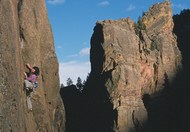Steep History: A Climbing History of Eldorado Canyon | Excerpt from Eldorado Canyon Climbing Guide
Posted by Steve Levin on 11th Jul 2024
By Steve Levin
The cliffs of Eldorado Canyon hold a significant place in the development of North American climbing. Advancements made here in technique, equipment, and style strongly influenced the trajectory of climbing and helped bring traditional, gear-protected climbing to its evolutionary high point in the 1970s. The following brief history touches on these advances. For a more thorough recounting of Eldorado (and Colorado) climbing, see the encyclopedic Climb! by Jeff Achey, Dudley Chelton, and Bob Godfrey.
EARLY EXPLORATIONS: PRE-1958
While the summits of the Bastille and Wind Tower were reached by work crews installing Ivy Baldwin’s cables in 1907, the first known “recreational” ascent of a major Eldorado formation was the 1925 ascent of Shirt Tail Peak, by two resort patrons. Mostly unknown and unreported are the 1920s and 30s solo climbs of Oliver Perry-Smith, a Philadelphia native who was university-educated in Europe and learned to climb in the early 1900s on the sandstone pinnacles of Dres- den, Germany. Perry-Smith retired to Denver and was a neighbor of local climber Rodger Raubach, who met the aging activist in the 1950s. At that time, Perry-Smith related that he had been coming to Eldorado Canyon “for years,” exploring the canyon’s steep walls solo. Considering the documented standards he earlier reached in Dresden—up to the 5.10 grade, often solo—any number of subsequently documented Eldorado climbs may have first been climbed by Perry-Smith.
Documented climbing in Eldorado Canyon arrived relatively late on the Boulder climbing scene. Not until the mid-1950s did local climbers shift their attention from Boulder’s Flatirons and begin exploring the walls of the canyon. This can be attributed to several factors: the wealth of unclimbed terrain remaining in the more accessible Flatirons, the perceived and real restrictions on access to the privately owned canyon, and a lack of the “pinnacle-like” summits that attracted climbers of that era. But perhaps the greatest impediment was the nature of Eldorado’s walls: unrelentingly steep, sheer cliffs rising hundreds of feet, with few obvious weaknesses or continuous crack systems.
The U.S. Army’s Tenth Mountain Division Climbing Group, which included among others Ray Northcutt, George Lamm, Harvey T. Carter, and Dallas Jackson, continued to train after the Korean War, with teams venturing to regional climbing areas, including Devils Tower and the South Platte. On one of these training ventures in 1954 or 55, two unknown climbers entered the privately owned Eldorado Canyon and climbed the most obvious and accessible line there, The Bastille Crack. Surviving members of the Tenth don’t recall who these climbers were; according to Ray Northcutt, they may have been “Eastern” members of the Climbing Group who returned home soon after being discharged from army duty.
The first documented climb in the canyon was Redguard Route, an obvious weakness on Redgarden Wall, climbed in 1956 by a core group of Boulder climbers: Dick Bird, Dallas Jackson, Charles Murley, Dale Johnson, and Cary Huston. The group immediately recognized the canyon’s climbing potential. Soon, members of the same group, and climbers including Stan Shepard, Allen Bergen, and Cleve McCarty, made other exploratory ascents, including The Anthill, Chockstone Chimney, and The Bomb (1956), and Southeast Chimney, Recon, and a direct start to The Bastille Crack (1957). These ascents followed prominent lines of weakness on the canyon’s walls, using techniques and equipment mastered in the Flatirons. No technical advancements were required for these ascents, but they did much to soften the intimidating aura of the canyon.
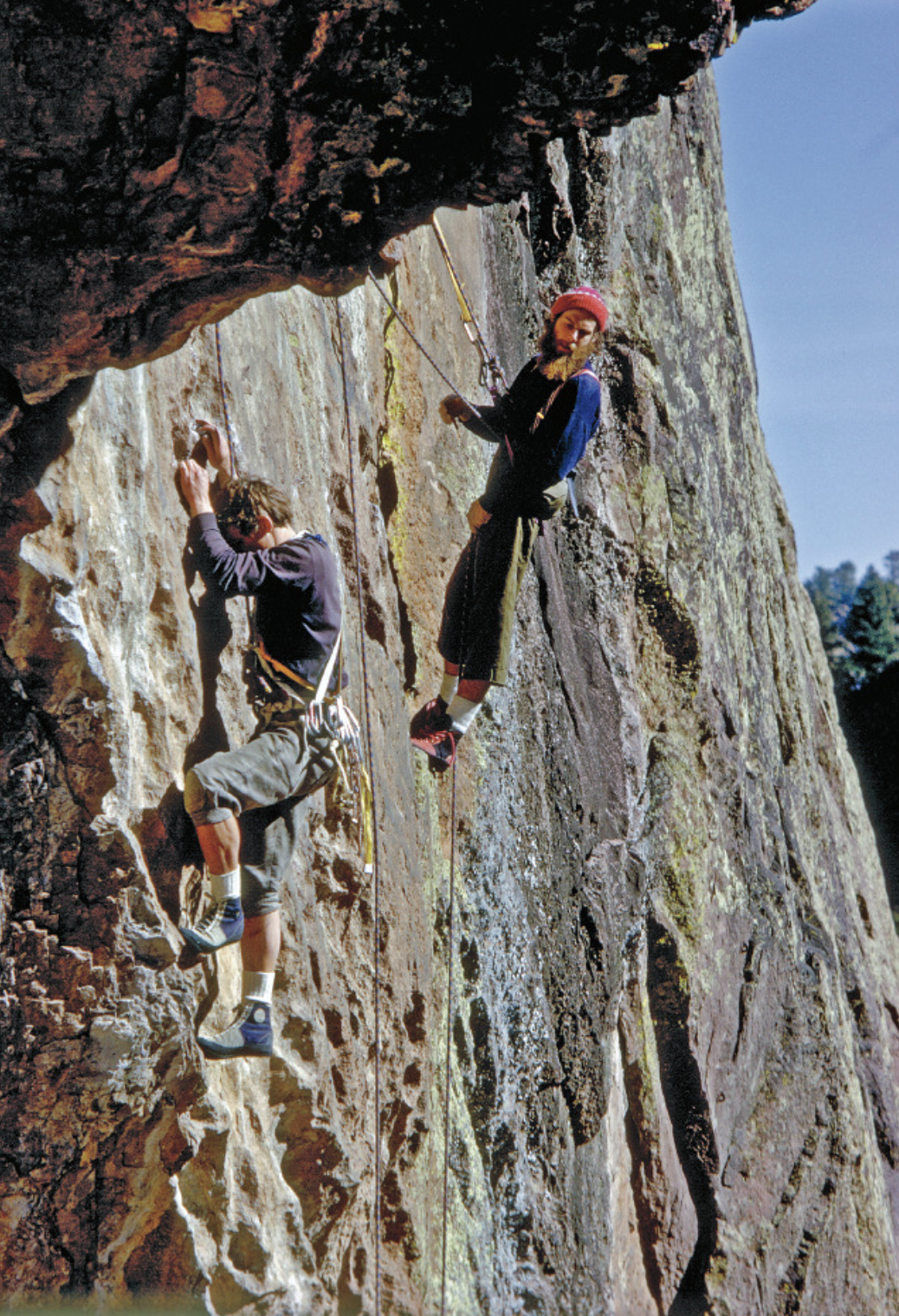
THE GOLDEN ERA: 1959-1967
In 1957, an outsider appeared around the periphery of this core group of Boulder climbers: a tall, gangly youngster named Layton Kor. Kor possessed unrestrained enthusiasm and energy for climbing, and soon embarked on a flurry of new-route activity that has never been equaled in the canyon’s history. His first new route, The Bulge (1957), was completely different from the established climbs: it followed an improbable line up an expansive, crackless section of wall. Kor climbed the route quickly and with little protection, and although he was criticized for recklessness, he had demonstrated that the open faces of Eldorado were indeed climbable. Within the next two years, he raised the climbing standard in the canyon considerably, establishing classic climbs including the Bastille’s Northwest Corner and West Buttress, T2 and The Yellow Spur on Redgarden Wall, and The Wind Ridge on Wind Tower (all climbed in 1959). Eldorado climbing was suddenly center-stage in the Boulder scene.
By 1960, Kor was joined by a new generation of climbers, including Bob Culp, George Hurley, Peter Lev, Dave Dornan, Charles Roskoz, Dave Rearick, and (in 1961) the young pair Pat Ament and Larry Dalke. This group began to systematically explore the canyon’s spectacular lines. The carefree attitudes of the late 1950s “Beats” influenced some of the members of this group, who made climbing a way of life instead of the part-time activity it had been for the earlier generation. Better equipment was now available, including the prized Chouinard hard-steel pitons, allowing many thin aid pitches to be climbed.
Most of the canyon’s great lines were climbed in the next few years. Redgarden Wall in particular, being the largest formation in the canyon, attracted a lot of attention, with the opening of Grand Giraffe and The Green Spur (1960), Ruper, Super Slab, and Vertigo (1961), Black-walk, C’est La Vie, Genesis, Psycho, The Wisdom, Le Toit, Rosy Crucifixion, Rover, The Serpent, Italian Arête, The Diving Board, and The Naked Edge (1962), and Grandmother’s Challenge, Kloeberdanz, Canary Pass, Exhibit A, and Le Void (1963), among others—plus numerous routes on the canyon’s other formations. All but three of the above ascents were spearheaded by Kor. A few years later, another mostly “post Kor” wave of Redgarden first ascents, dominated by Ament and Dalke, added Night (Kor, his last hard FA in Eldorado), Centaur, Jules Verne, Book of Numbers, Fire and Ice, Evangeline, Temporary Like Achilles, Revelation, Deception Passed, and Love Minus Zero (1967), and Saint Augustine (now “Much Slater”) and Mellow Yellow (1968).
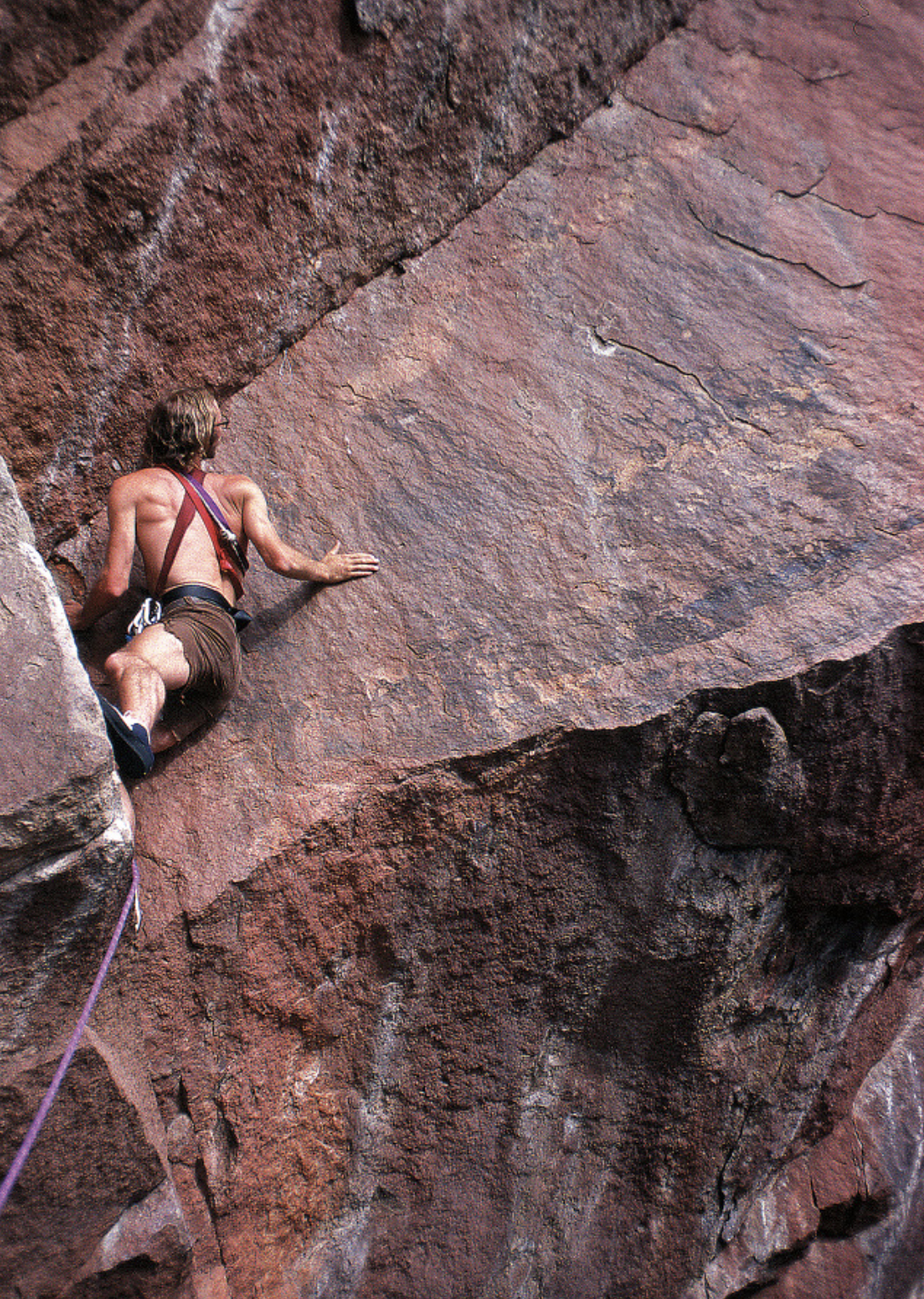
The style of the day applauded speed and difficult aid, and much of the climbing was treated as training for the “big walls”—especially the granite monoliths of California’s Yosemite Valley—and the Alps (hence route names like The Yellow Spur and Grand Giraffe). Most routes were done using a combination of aid and free climbing—whatever was most efficient—and free climbing, unless it contributed to speed, was not valued to the degree it is today. The concept of free climbing as an end goal was still being developed. The emphasis was on a fast, all-around climber who could overcome any technical challenge, and indeed, Eldorado Canyon had some of the most challenging aid pitches in the world in the early 1960s, albeit on mere “practice” routes.
When pressed, these climbers were capable of very high-level free climbing, evidenced by Ray Northcutt’s famous free ascent of the direct start to The Bastille Crack (5.10d, 1959), Rearick and Culp’s free ascent of T2 (1962), and Kor’s lead of the wide crack on Grand Giraffe (5.9+, 1960), which was impossible to aid (or protect), and Black Jack (5.10 R, 1963). Ament and Dalke, in addition to their new routes, also developed a particular interest in free climbing. Between them, they freed many difficult pitches, including Dalke’s complete free ascents of The Green Spur (1964) and XM (1967) and Ament’s efforts on Supremacy Crack, Vertigo, and the Northwest Corner of the Bastille (all in 1966), and Super Slab (1967). All of this free climbing was accomplished in footwear similar to modern-day approach shoes, sans the sticky rubber, and protected using pitons hammered in with one arm while hanging from the other.
Kor’s last Eldorado FAs occurred in 1968—obscure routes on Hawk-Eagle Ridge and Upper Peanuts—and soon he left climbing altogether. Shortly thereafter, Ament began a lengthy absence from climbing, and soon Dalke also lost interest. The golden age of exploration and development was coming to a close, although climbing activity in the canyon continued along. The major aid lines were still top on the list of aspiring Eldorado climbers, being prime training for the big walls of Yosemite. Repeated ascents of climbs like The Naked Edge, The Diving Board, Psycho, Rosy Crucifixion, and others left much-fixed gear in place, soon to be utilized by a new generation of free climbers.
FREE AND CLEAN: 1968-1975
Change was on the horizon. In 1966, Yosemite hardman Royal Robbins returned from a climbing trip to Britain and introduced the use of chocks in the United States. Two years later, Robbins climbed Grand Giraffe with Pat Ament and Jamie Logan carrying no pitons. That same year a newcomer appeared on the scene: Jim Erickson. A recent transplant from Wisconsin, where he learned to climb at the compact, technical quartzite of Devil’s Lake, Erickson seemed to have no interest in aid climbing. He worked through the established free routes, then began adding his own. His early free ascents included Tagger, The Grand Course, and Grandmother’s Challenge (all in 1968), and in 1969, Rincon and Black-walk—the latter a psychological breakthrough as the first of the 1960s “A4” routes to be led free. His explorations of the relatively undeveloped West Ridge around this time yielded that crag’s first 5.10 route, Break on Through, and along with the Bastille’s Hair City, hinted at Erickson’s soon-to-manifest drive to explore.
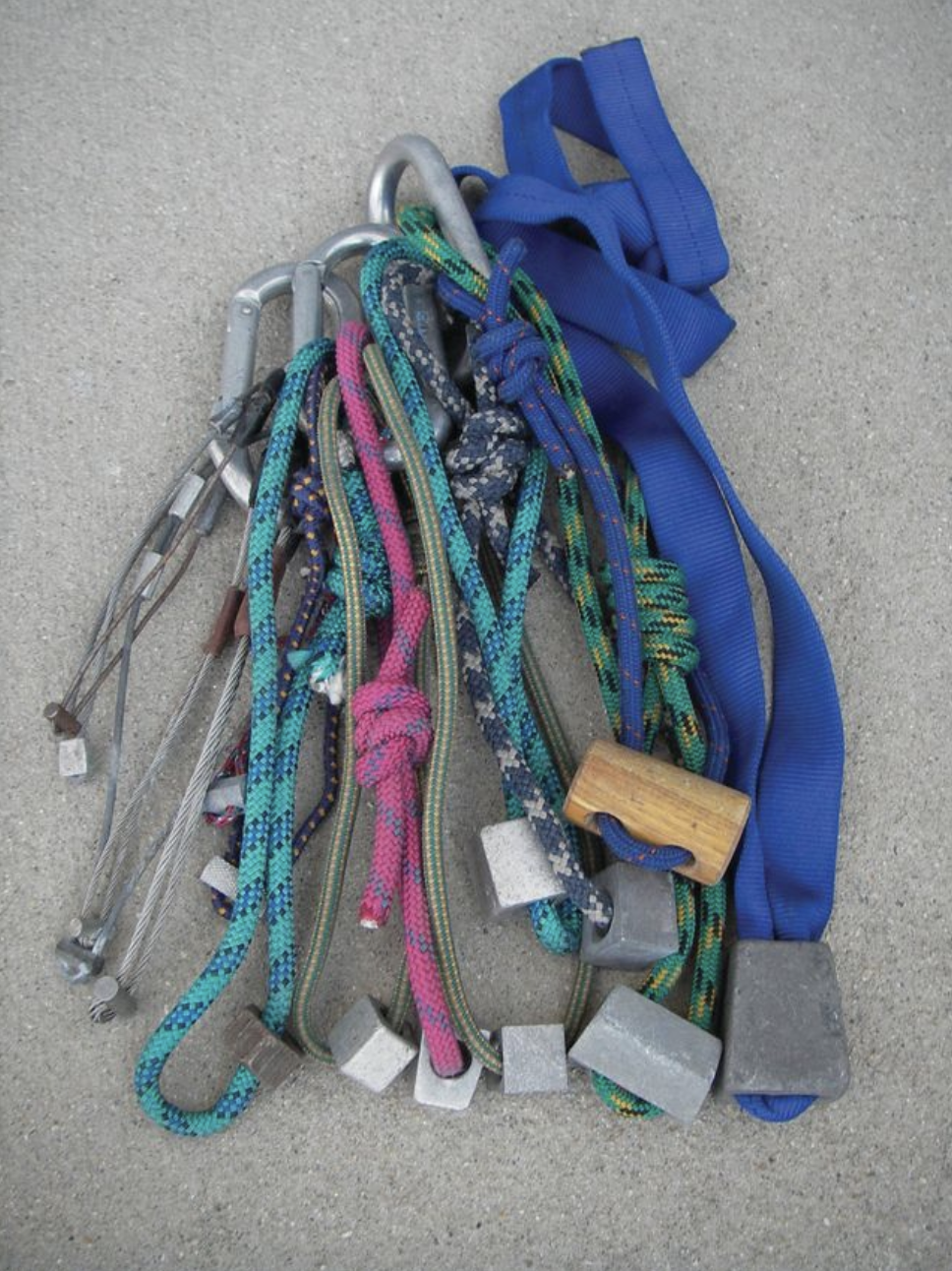
As the 1970s began, several cultural events influenced the trajectory of rock climbing. April 1970 saw the first Earth Day, a nationwide grassroots demonstration on behalf of the environment. A heightened interest in the outdoors and outdoor recreation followed, and soon the sport of rock climbing began to enter the mainstream consciousness. Also, the late 1960s counterculture produced a generation of young individualists, strongly influenced by Eastern philosophies, willing to forgo the trappings of the modern working world in favor of a more free-form existence. These events converged to usher in the “clean climbing” revolution, a new climbing paradigm defined by the use of non-destructive gear— notably the “chock” (see essay on page 262)—and a ground-up approach to climbing based on respect for the rock and guided by an introspective philosophy.
By 1970, Erickson and a small group of climbers began to systematically free-climb the great aid lines of the 1960s. Redgarden’s exposed nail-ups Rosy Crucifixion (1970) and Le Toit, and the Bastille’s Outer Space (1971), were some of the next aid routes liberated. Interestingly, two of the most intimidating and biggest prizes were also among the earliest to fall: The Diving Board, by Roger Briggs (1971), and The Naked Edge (1971), where Erickson teamed with Duncan Ferguson, a yoga-practicing, naturally gifted climber, to produce one of the enduring American classic rock climbs. 1972 saw two remarkable free-solo first ascents by Erickson, Blind Faith, and the FFA of Sooberb. The runout Wide Country was freed “all-nut” by Ferguson, and the first “true” Roof Route went free, Guenese. The next year, things really began to take off.
All of these routes were approached ground-up, using the remnant fixed pitons and other relic aid-climbing mank, along with the primitive (by today’s standards) early wired nuts and larger Chouinard Hexentrics. By 1972 pitons were no longer being carried by the leading climbers. One consequence of this approach was the runout nature of many 1970s Eldorado testpieces, combined with the often frustrating location of many bolts, originally placed for aid progress with no thought of utility for free climbing. These ascents sometimes involved a communal effort, the 1970s “yo-yo” leads, wherein climbers took turns pushing the highpoint and gear placements until one succeeded in reaching the belay.
The years 1973 and 1974 produced an impressive number of bold new free climbs. Joining Erickson, Ferguson, and Briggs were Art Higbee, Chris Reveley, Rob Candelaria, and the itinerant Eastern climbers Steve Wunsch and John Bragg, among others. The list of their free ascents is long and includes Scotch ‘n’ Soda, Metamorphosis, DOA, Rover, and Psychosis (1973), and The Serpent, The Uplift, Neurosis, Captain Beyond, and Kloeberdanz (1974). This last route, by Wunsch, involved very gymnastic, dynamic “roped bouldering” that was very exotic at the time.
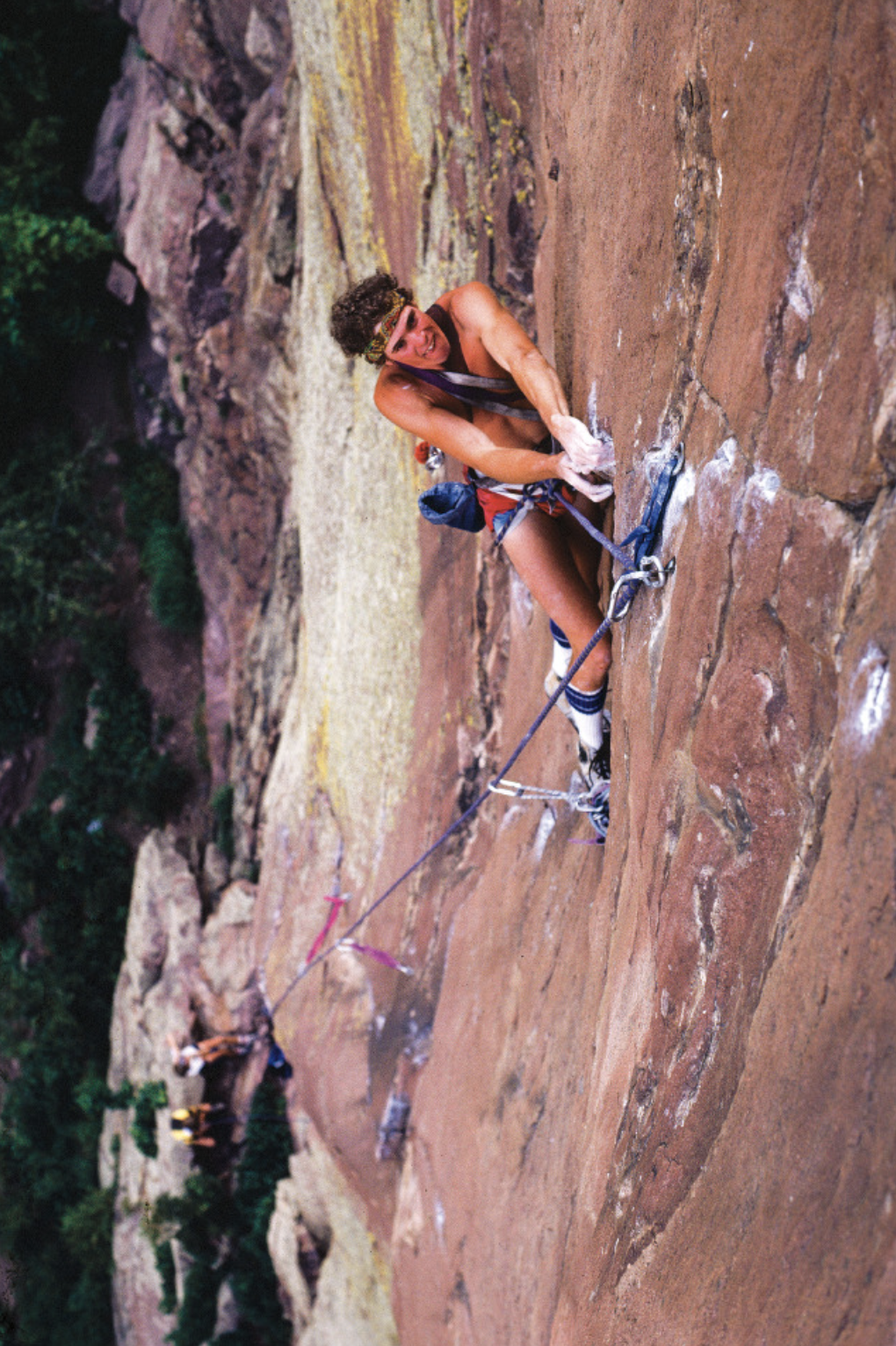
1975 saw a not-so-subtle divergence of climbing styles among the cutting-edge climbers. Erickson by this time had evolved a purist approach, where the ideal was a “naked, on-sight” ascent. Though Erickson generally kept his pants and climbing shoes on, he refrained from using chalk, and if he took even a single fall, he would retreat and never return to the route. Wunsch, on the other hand, while also able to climb very bold routes without falling, for example Jules Verne, was most partial to lengthy sieges—sometimes involving dozens of falls. This approach was a precursor to modern sport climbing, and created routes of upper difficulty such as The Mellow Spur and, notably, Psycho, the canyon’s first 5.12 route. 1975 also saw the appearance of a young outsider to the core climbing group, David Breashears, who famously repeated Kloeberdanz, on-sight, statically, and with little struggle, and soon after began a string of ascents of his own, all in impeccable style: Rain, Love Minus Zero, Saint Giraffe, Old Bad Aid Crack, and most notably his two “mind-control” testpieces at Mickey Mouse, Krystal Klyr and Perilous Journey.
AN EVOLVING SPORT: 1975-1983
By 1975, “free and clean” was the accepted climbing ethos, and Eldorado was firmly established as one of the great national climbing centers. Ament’s Eldorado: A Climber’s Route Guide was published that year, the first guidebook focused exclusively on Eldorado. Over the next few years, however, many of the early 1970s free-climbing luminaries would leave the area, shift focus to other areas (such as the Diamond), or quit climbing and go on to other pursuits. Still, many of the canyon’s walls were sparsely developed, and Dan Hare, Scott Woodruff, Jim Michael, Chris Reveley, and others, along with occasional appearances by Erickson or Briggs, continued to ferret out new routes, some now regarded as area classics.
The next major aid line to fall was the spectacular, much-attempted Roof Route, The Wisdom, freed (with
a short variation at the crux) in a quick effort by visiting Californian John Bachar in 1977. A new crop of young climbers had moved to town and began to fill the void left by the 1970s pioneers, many inspired by the Eldorado photos in Godfrey and Chelton’s 1977 book Climb!. In 1978, the canyon became a state park. That same year saw John Bragg finally free Cinch Crack (the canyon’s first “official” 5.12, since a key broken hold had rendered Psycho ambiguous and unrepeatable), Chris Reveley free climb the unheralded Zambezi on Mickey Mouse, and Jeff Lowe launch into the unknown with his ascent of the Bastille’s Inner Space.
A shift in climbing styles was emerging. In 1979, Jim Collins took Wunsch’s siege ethic to the extreme on Genesis, attempting the route over a hundred times before finally bringing a new free-climbing standard to the canyon. Genesis was also the first route where old aid bolts were upgraded to protect free-climbing attempts. Also in 1979 was the first ascent of Aerospace, the first “post-clean-climbing” ascent in the canyon “forced” up a blank feature by using bolts (placed “ground-up”) for protection.
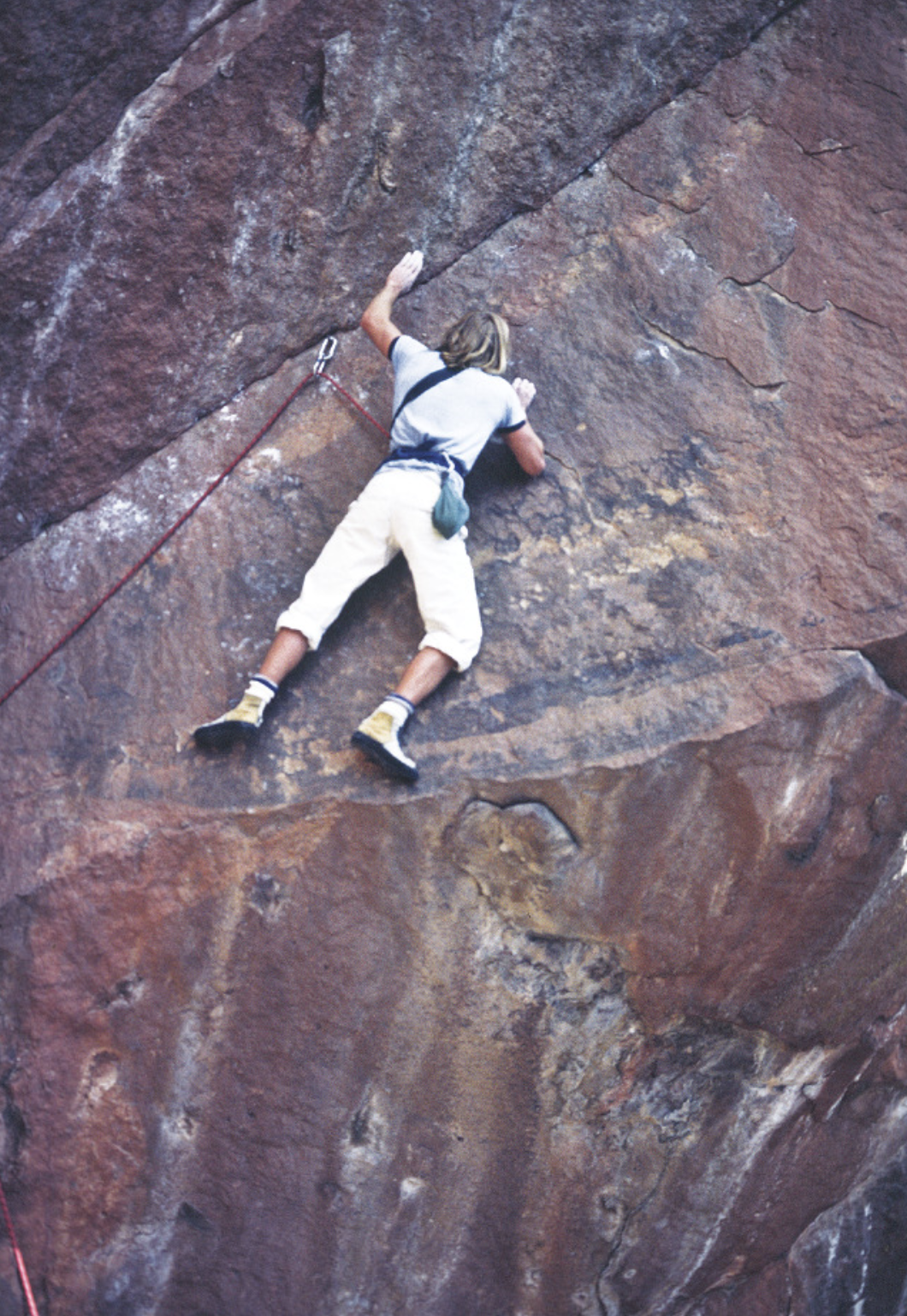
A new surge of free ascents began in 1980. CU student Jeff Achey freed Salvation, Wendego, Night, and in 1981, Beginner’s Mind, Apple Strudel, and Le Void. Roger Briggs demonstrated that he was still on top of his game with his ascent of the brilliant Scary Canary. The most prolific first-ascensionist of this time was Alec Sharp, an ex-pat British climber who broke the traditional mold in several ways, with frequent use of rappel previewing, and a preference for new terrain over freeing old aid routes. Sharp’s bold climbing and keen eye for a subtle line produced dozens of runout and dangerous routes in the next few years, including The Human Factor, False Prophet, Climb of the Century, Kindness (1980), Tanqueray, Kubla Khan, Ministry of Fear (1981), Danger-ous Acquaintances, and Way Honed and Gnarly (1982). Skip Guerin also contributed, with climbs including Blues Power, Sheer Terror, and Superfly, the latter being the most difficult all-gear lead in the canyon when done in 1983. Although most of these climbs were done ground-up, the strict 1970s ethic was bending: Sharp, in conventional British style, previewed many of his routes on rappel; Salvation was previewed on rappel and its old bolts replaced; and Scary Canary was first done on aid, with a few pitons and bolts left fixed. The teenaged team of Eric Doub and Christian Griffith bolted and pitoned their way up their route The Doub-Griffith, offending many with their brashness but creating what is now a well-regarded classic, and a portend of things to come.
BOLTING AND CONTROVERSY: 1984-1989
A brief barefoot-climbing fad broke out in the mid-1980s, yielding some unlikely shoe-less ascents including The Naked Edge (Achey) and the extreme micro-edging of Wendego (Guerin), but a more fundamental change was coming. Several factors contributed: a significant expansion in the number of local climbers; a more detailed and refined inventory of the canyon’s walls; and—the bolt, placed on rappel to protect free climbing. One significant route was Rainbow Wall, a recent aid line on the Wind Tower offering vertical, desperately thin, bolt-protected free climbing, which Bob Horan “redpointed” (at the time a new term) amidst tremendous competition in 1984 (see page 80).
Also in 1984, after gaining considerable fitness from a trip to Europe, Christian Griffith repeated Rainbow Wall with ease, then in 1985 went on to free climb the traditionally protected Red Dihedral at Mickey Mouse with Eric Doub. Later that year, Griffith became the first local climber to shamelessly advocate “sport” climbing in Eldorado, taking the huge step of rappel-drilling a blank wall high on West Redgarden, Paris Girl. Perhaps no other climb best signifies the new generation’s split from the old styles of the 1970s and early 1980s. The climb was instantly a lightning rod of controversy, and soon suffered the first of several bolt choppings by traditionalists.
Soon other rap-bolted lines appeared. In 1986, Dale Goddard added The Sacred and Profane at Peanuts (he also led the all-gear Evictor that year). Other bolted routes done in 1986 include Je t’aime, Downpressor Man, Captain Crunch, Wingless Victory, Predator, and the retro-bolted Centaur. At the forefront of Eldorado sport climbing were numerous other strong climbers, including Mark Tarrant, Bob Horan, Darius Azin, Dan Michael, Charlie Fowler, and Mark Rolofson. The standard of the day was set by Griffith’s Desdichado, located front and center on Redgarden’s Lower South Buttress.
This was sport climbing in its infancy. Two general trends soon emerged: a quest for extreme, gymnastic difficulty, strongly influenced by visiting European climbers and developments in Oregon’s Smith Rock; and an effort to produce safe 5.10 and 5.11 face routes for the enjoyment of others. The first routes established relied on bolts to protect the new ground, but intentionally minimized their use, incorporating the concept of controlled climbing on “moderate” (5.10 and 5.11), 1970s-style terrain while using bolts to protect the “new wave” climbing—a contrived approach by modern standards. Two climbers notable for their high-quality, well-crafted, more moderate routes were the husband and wife team of Richard and Joyce Rossiter. With an eye for a line, together they established many enduring classics including Point Break at Rincon, Sunrider at Peanuts, and Zen Effects at Mickey Mouse.
By 1986 the sport-climbing approach was in full swing, and numerous bolted routes were established throughout the canyon including such classics as French Fry, Camouflage, and The Web. The canyon’s first encounter with the power drill came soon after, with Colin Lantz’s Bastille classic, Your Mother (1988).
With the rapid pace of development and new bolts appearing seemingly anywhere and everywhere, a backlash began. Many climbers, even those who embraced the new paradigm, still felt Eldorado Canyon
was different, that it should not become a fully bolted area, that there was a unique climbing style that should be protected. Several routes encroached too closely on traditional lines, including Back in Black near Night, Asahi near Perilous Journey, and the bolted arête of Genius Loci, installed in 1989 within feet of The Naked Edge and Jules Verne—which really unleashed the traditionalists’ ire. The straw that broke the climber’s back came when two well-intentioned locals removed fixed pins, placed bolts, and moved belays on area classics including The Bastille Crack, Rosy Crucifixion, and Guenese, resulting in contentious, vitriolic exchanges that were noticed by the state park.
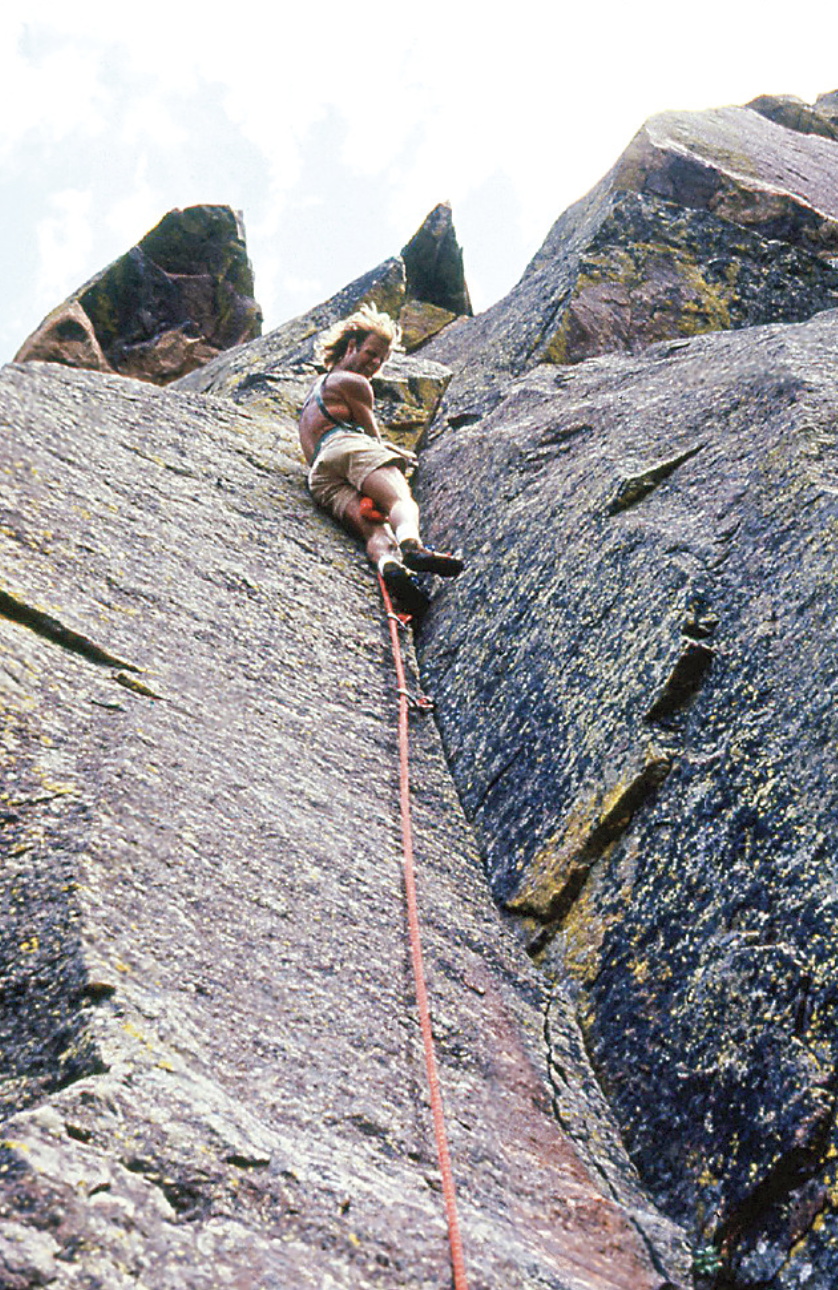
A REGULATED SPORT: 1990-1999
The park’s primary mandate was to preserve park resources, and climbers were clearly impacting these. The era of climbers individually and unilaterally placing bolts or altering existing routes quickly came to an end. As the bolting controversy reached its climax, the park imposed a bolting moratorium. Climbers eager to push the standards were forced to go elsewhere, to the newly developing areas such as Rifle—as well as the Industrial Wall at Mickey Mouse. Unlike most of the main canyon, the severely overhanging walls at lower Mickey Mouse were perfectly suited to the evolving sport-climbing paradigm, and climbers Colin Lantz, Jim Hall, George Squibb and others made good use of the short period between the closing of Eldorado to bolting in 1989, and the same at Mickey Mouse in 1993.
Other climbers, however, wanted to continue activity in the canyon, and pursued avenues with the park to this end. The result was the formation of the Action Committee for Eldorado, and its functional arm, the Fixed Hardware Review Committee.
Through a cooperative effort between area climbers and the park, a system was devised to allow for continued development, through community consensus, while preserving the historical and environmental aspects of the canyon’s climbing—one of the nation’s first climbing- management models of its type. Although there have been some rough spots, the FHRC system has been successful and continues into the present day.
But restrictions and formal application procedures were anathema to many climbers’ perceived spirit of freedom, and many lost interest in Eldorado altogether as a venue for new route development. The rest of the 1990s was generally unremarkable, particularly at the high end of the sport, with two notable exceptions that occurred at the end of the decade: the redpointing of Vogue and the complete Terminal at the Industrial Wall by Tommy Caldwell, both still among the hardest routes in the Boulder area.
HEADPOINTING, HARD TRAD, AND FHRC-APPROVED ROUTES: 2000-PRESENT
At the end of 1999, the British video Hard Grit reached the shores of America and touched off a new route mini-explosion in Eldorado, where climbers started using the “headpoint” strategy featured in the video (see page 250). Developed on the crowded, boltless gritstone cliffs of England, this toprope-rehearsal approach was well-suited to Eldorado, where unclimbed lines were often squeezed near established classics (and thus unlikely to receive FHRC bolting approval), or involved sections of suspect rock and poor protection with risks few climbers were willing to take without prior knowledge and practice. A number of climbers adopted its use, resulting in many ascents, both notable and obscure. Highlights include Andy Donson’s The Lion (2000), Eric DeCaria’s Musta’ Been High (2001), Topher Donahue’s ‘Fraid Line (2002), Rolando Garibotti’s Restless Nights (2004), Marc Gay’s Grim Reaper (2008), and more recently, Matt Reeser’s Turkey Jerkey (2016) and Tanner Bauer’s Gluttony (2019). Together with the difficult, gear-protected Freeline (Justen Sjong, 2000) and Iron Monkey (Matt Segal, 2005), and the bolted Black Pearl (Eric DeCaria, 2007) and The Art of Slappiness (Chris Weidner, 2007), the early 2000s found Eldorado back on the cutting edge of hard climbing.

